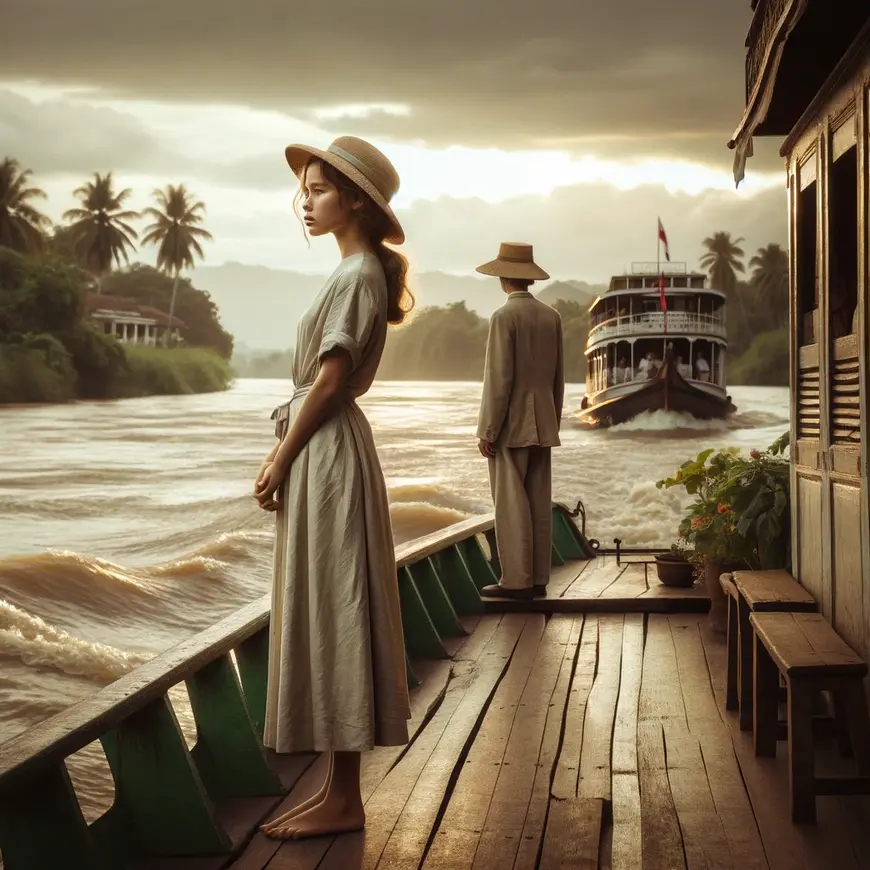Elegance in Forbidden Love – A Review of “The Lover” by Marguerite Duras
My Takeaways from reading “The Lover” by Marguerite Duras
“The Lover”, by Marguerite Duras was a captivating read. The poetic language and vivid imagery in the novel immediately drew me into the story. The portrayal of a forbidden love affair between a young French girl and a wealthy Chinese lover was both enchanting and poignant.
On a level the book resonated with me on a level. I could feel the girls yearning and vulnerability as the complexities of their relationship. The struggles and barriers they faced in their love story struck a chord with me. Durass ability to convey emotions with simplicity was truly remarkable.
From a standpoint the novel sparked reflections, on love, identity and memory. The non linear narrative style and introspective approach encouraged me to contemplate how our past influences our selves. The cultural clashes and family dynamics woven into the narrative added depth to the storyline making it a compelling and thought provoking read. This book left me contemplating life and appreciating Duras storytelling craft.
In the sultry embrace of French colonial Vietnam, where societal norms clash with the intoxicating pull of passion, Marguerite Duras weaves a spellbinding tale of desire and taboo in her novella “The Lover.” With prose as evocative as a lingering caress, Duras transports us to a world where cultural boundaries blur, and love blooms amidst the humid air of nostalgia. Through her poignant narrative, she unearths the layers of human emotion that thrive in the shadows of societal constraints.
A Love Story Beyond Boundaries: The World of “The Lover”
Picture the Mekong Delta in the 1920s, a land simmering with unspoken tensions between colonialism and native identity. Against this backdrop, a young, nameless French girl encounters an enigmatic Chinese lover, a man she refers to as “the lover.” Theirs is a love that defies convention and defies societal expectations. The novella’s non-linear structure, a weaving of memory and reflection, draws readers into the whirlpool of forbidden passion.
Duras captures the essence of colonial Vietnam with vivid descriptions, transporting us to a world of lush landscapes, bustling Saigon streets, and the underlying tension between different cultures. As the backdrop shifts from the girl’s provincial hometown to the bustling city, readers are enveloped in a sensual atmosphere that mirrors the characters’ burgeoning emotions.

An Ode to Elegance: The Protagonist and the Lover
The heart of “The Lover” beats within its unnamed characters – the girl and the lover. The girl, a rebellious and introspective 15-year-old, navigates the stifling expectations of her family and society. Her inner thoughts and contemplations are laid bare, allowing readers to experience her emotions in their rawest form. Her attraction to the lover becomes a refuge from the oppressive world around her, a world where she yearns to be seen and loved for who she truly is.
The lover, a wealthy Chinese man, is a study in contrast – both enigmatic and vulnerable. Duras peels back the layers of his character, revealing his own struggles with identity and his complicated relationship with his family. The dynamic between the girl and the lover is one of power imbalances and fleeting intimacy, fueled by the fiery attraction that arises when worlds collide.
“The Lover”: Sensual Elegance and Elegance in Sensuality
Duras’ prose is a testament to the power of language to evoke emotion. Her writing is spare yet rich in detail, each sentence a brushstroke that paints a picture of yearning and sensuality. The novella’s lyrical beauty is not just in the words themselves, but in the spaces between them – the unspoken desires that hang heavy in the air.
The story’s sensuality is both palpable and understated. Duras masterfully weaves the physical and emotional aspects of the girl and the lover’s relationship, crafting a narrative that captures the intensity of desire without descending into the explicit. The stolen moments, the secret glances, and the clandestine rendezvous serve as a testament to the power of subtlety in storytelling.
The Complexity of Desire and Identity: Themes Explored
Beneath the veneer of a forbidden romance, “The Lover” delves into desire and identity. The girl’s attraction to the lover is not just simple infatuation. It forces her to confront her own sense of self. Her relationship with the lover becomes a mirror. She examines her identity as a French girl in a foreign land. She struggles to find her place amidst clashing cultures.
The novella also explores class and race intersections. The lover’s Chinese heritage and outsider status comment on colonial-era prejudices. The girl’s social status and family expectations add more hurdles. Duras skillfully navigates these complex themes. She uses the characters’ experiences to shed light on societal constraints shaping their lives.
Time and Memory: The Elegance of Reflection
“Time, which sees all things, has found you out,” writes Duras, while time and memory are recurring motifs in the novella. The story is told through the lens of memory. The older version of the girl reflects on her past experiences. This narrative choice adds layers of depth. Readers see the older girl’s contemplations on her youthful decisions. They see the reverberations these decisions had on her life.
The interplay of memory and reflection underscores the ephemeral nature of love and the passage of time. It reminds us that youthful intensity and forbidden passion can lead to complexities and regrets in adulthood. Duras captures this transition with a delicate touch. She highlights the poignancy of nostalgia and the weight of our choices.

Famous Quotes from “The Lover” by Marguerite Duras
- “Very early in my life, it was too late.”
- Explanation: This quote reflects the theme of lost youth and the premature end of innocence. The narrator feels that significant parts of her life and opportunities were over before she had the chance to fully experience them, indicating a deep sense of regret and fatalism.
- “I’ve never written, though. Not that I can remember. I’ve never written but that’s all I’ve done.”
- Explanation: This paradoxical statement highlights the narrator’s complex relationship with writing. It suggests that while she may not have physically written much, the act of storytelling and the experiences that fuel her narratives have consumed her life.
- “I see journalists and I feel like I’m someone else, I realize I don’t know who I am anymore.”
- Explanation: This quote underscores the narrator’s identity crisis and the disconnection between her public persona and her true self. It reflects the theme of alienation and the struggle for self-understanding in the face of external scrutiny.
- “You don’t ever have time to do anything but live your life.”
- Explanation: This quote speaks to the urgency and relentless passage of time. It suggests that life moves so swiftly that there’s barely time to reflect or change course, emphasizing the inevitability of living within the constraints of time.
- “I often think of the image only I can see now and will ever see again. The image of the lover’s hand emerging from the sleeves of the blue suit.”
- Explanation: This quote illustrates the lasting impact of the narrator’s relationship with her lover. The detailed, sensory memory of a simple gesture captures the depth of her emotional connection and the significance of small moments in defining their love.
Trivia Facts about “The Lover”
- Autobiographical Elements: “The Lover” is heavily based on Marguerite Duras’ own life experiences. The novel recounts her youthful love affair with a wealthy Chinese lover in colonial Vietnam, reflecting her personal history.
- Publication and Awards: The novel was first published in 1984 and went on to win the prestigious Prix Goncourt, one of the highest literary honors in France. This recognition cemented Duras’ reputation as a leading figure in contemporary French literature.
- Writing Style: Duras employs a distinctive, lyrical, and fragmented writing style in “The Lover.”
- Film Adaptation: “The Lover” was adapted into a film in 1992, directed by Jean-Jacques Annaud and starring Jane March and Tony Leung Ka-fai. The film closely follows the novel’s plot and visually captures the lush, colonial setting of Vietnam.
- Themes: The novel delves into themes such as forbidden love, colonialism, racial and social boundaries, and the complexities of human relationships.
Relevance and Elegance Across Time: “The Lover”
Though “The Lover” is set in a specific time and place, its themes are universal. Desire and societal expectations collide, leading to self-discovery and cross-cultural relationships. These themes resonate across eras and cultures. In a world shaped by external pressures, the girl’s journey to claim her desires serves as a reminder. Authenticity is a constant pursuit.
Moreover, Duras explores the transient nature of passion and the inevitable passage of time. This holds relevance in today’s fast-paced world. The novella encourages readers to savor fleeting moments. It prompts reflection on life choices and the elegance in desire, identity, and memory.
Final Thoughts: A Masterpiece of Elegance and Emotion
Marguerite Duras’ “The Lover” is a masterclass in elegance. The lush prose evokes a world steeped in desire. The narrative explores human emotions and societal constraints. Through the girl and the lover’s forbidden romance, Duras captures the beauty and pain of love. She dissects layers of identity and desire.
As we journey through the girl’s memories, we are reminded of the complexity of love and authenticity. “The Lover” leaves an indelible mark. It reminds us that beneath societal norms and masks lie the heart’s deepest desires. The novella invites us to explore our own souls. It encourages us to confront vulnerabilities and embrace the elegance when society and passion collide.
More Reviews of Works by Marguerite Duras
An Intimate Voyage Through Time and Memory – A Review of Marguerite Duras’ “Savannah Bay” Duras’ Elegy of Love and…
